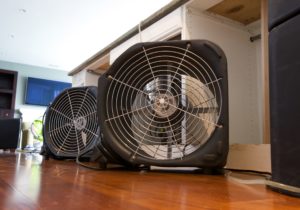
If your home has been affected by a flood or water leak, the way you deal with it will affect how safe your home is, specifically the structure, in the days, weeks, and months afterward. Improperly drying the area can lead to additional problems such as mould and mildew growth or the spread of bacteria throughout your home. Learning about how structural drying works can help you see the value of hiring a professional flood damage restoration team to handle the job. What is structural drying? Here’s everything you need to know.
What Is Structural Drying
Structural drying is the process of removing excess water and moisture from materials that make up a structure, until it is dry enough to meet a certain standard of dryness and safety. If your home has been flooded, a professional flood damage restoration company can thoroughly dry out the area to get rid of the water and any extra moisture that could lead to mould growth.
Principles of Structural Drying
Water Extraction
The first principle of structural drying is water extraction. While there are a few different extraction methods, physical extraction is the fastest way to remove the water. If the carpet has been soaked, it may take longer for the area to dry, and the carpet may need to be pulled up. This is not necessary in all cases.
Airflow
Once most of the water has been physically extracted from the area, the remaining moisture needs to be evaporated using high velocity air movers. Advancements in technology have designed new types of air movers that are available specifically for rapid structural drying. They offer a high volume of air movement using less energy to improve efficiency.
Dehumidification
Even though the moisture may be dried out from the floors or drywall, it doesn’t mean it is completely gone. Moisture evaporates and becomes a vapour that stays in the air. Without dehumidification, this moisture can absorb back into the materials of the home and continue to damage your property. Mould growth would begin to form and you will likely have another issue to deal with. The dehumidification process is essential to preventing mould growth and removing the excess moisture from your home.
Temperature Control
The ideal temperature for a home is between 20 and 32 degrees Celsius, especially for the first 36 to 48 hours of drying. Cooler air tends to slow down evaporation, so the extra warmth helps the evaporation process. If the air is too hot, above 32 degrees Celsius, the dehumidifier will not be as effective.
Hi-Tech Equipment Used
It’s important to note that if you want your home thoroughly dried after water or flood damage, you will need the assistance of the professionals. The advantage of working with a professional team is that they have the high-grade equipment necessary to dry out any excess moisture and prevent the risk of mould growth. They will have high-grade industrial dehumidifiers, air movers for large volume drying, inject-dry systems to promote air flow within the walls and floorboards, and air scrubbers to clean away any airborne particles such as pathogens, mould spores, sawdust, or drywall dust. If the source of water is from a sewage backup, it is even more important that you ask the professionals to handle the situation.
Benefits of Structural Drying
Saves Time
With a professional team handling the structural drying of your home, the process is fast and efficient. They will work until the job is completed, so you can get your home back to normal as quickly as possible.
Prevents Secondary Damage
Preventing additional damage such as mould growth and the spread of bacteria is another part of the structural drying process. The professionals have the equipment and processes necessary to ensure your home is completely dry, so you don’t need to worry about lingering moisture.
Not Destructive
The structural drying process the professionals use helps to preserve the integrity of critical building materials. If water and moisture have seeped into wood, drywall, and other materials in the area, they will do their best to prevent further damage to your property.
Prevents Mould Growth
Through their air drying and moisture removal processes, they will minimize mould and mildew risks. Mould spreads through the air and can lead to problems in other areas of your home, which is why this step is so important.
Contact Flood Services Canada’s Structural Drying Service
Mopping your floors and airing out your mats and materials isn’t enough to get rid of lingering moisture or bacteria from water damage. Many homeowners and business owners don’t realize the risks of lingering moisture, but our professionals do. We will do everything within our ability to make your experience as pleasant as possible by giving you peace of mind that the area is completely dried. Our professionals will determine the source of the water and use our efficient processes and equipment to remove hazards, clean your flooded area, and completely dry it out. With our high-tech drying equipment, we will remove all traces of moisture, so you won’t need to worry about mould showing up in the weeks after.
If you need quick water damage restoration, Flood Services Canada can help you. We deploy our quick-response teams to cities across the Greater Toronto Area to help homeowners save their home in emergency situations.
Our services include 24/7 sewage, water damage, and food cleanup and our technicians will use the best techniques and equipment to ensure your home is clean, safe, and dry as soon as possible. Contact us at (416) 302-2107 to learn more about our structural drying services or use our emergency hotline at (416) 999-3930 to get our rapid-response teams deployed to your location.
